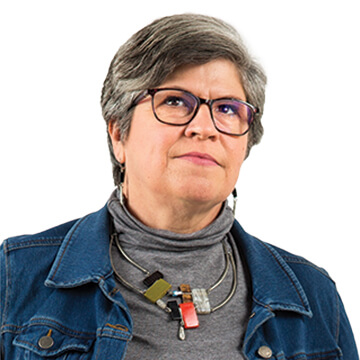- February 03, 2021
- By Sala Levin ’10
As the numbers of Americans dying of COVID-19 continued to climb, with no end in sight, Elizabeth Katt MFA ’22 struggled to visualize the loss. What does 100,000—of anything—look like? What about 200,000? 400,000?
“It is really hard to wrap your head around a number and have that be real,” Katt said. So she decided to turn intangible numbers into something plain to see: tally marks on adding machine tape.
 For her project, “an accounting,” Katt sits on a stool in a bare-bones studio in the Parren J. Mitchell Art-Sociology Building (open only to a small number of graduate students) and tracks, by hand, everyone in the United States felled by the virus, according to data from Worldometer. As she tallies, she livestreams the sessions, inviting questions and comments from online viewers.
For her project, “an accounting,” Katt sits on a stool in a bare-bones studio in the Parren J. Mitchell Art-Sociology Building (open only to a small number of graduate students) and tracks, by hand, everyone in the United States felled by the virus, according to data from Worldometer. As she tallies, she livestreams the sessions, inviting questions and comments from online viewers.
Katt has divided the project into long sessions; on Election Day last year, she made marks from the time polls opened on the East Coast to the minute they closed on the West Coast. “Part of (the project) is the time it takes,” she said. Add to that the intentional discomfort of sitting on an unpadded stool for hours at a time. “I don’t think the image of a cushy chair would be what I wanted,” Katt said. “I knew wanted it to be a grind because (living through the pandemic) has been a grind.”
A former nurse who served eight years in the U.S. Air Force, Katt knows firsthand what it means to keep company with the dying. Katt, a civilian working in hospitals, cared for pediatric oncology patients and patients critically ill with AIDS. “Having been a nurse is a big way how I see the world, because I am very in tune to people and people’s suffering,” she said. “Those kinds of things tear at me.”
After leaving the Air Force, where she worked in a same-day surgery unit and recovery room, Katt found herself in a series of unfulfilling jobs. Eventually, “I started to consider things I had always wanted to do, and art-making was what was calling me.” Her GI Bill benefits made returning to school an easy choice.
 Katt’s tally marks are color-coded to represent how the U.S. compares to other countries in its handling of the pandemic, based on data from Columbia University. One color, a dark orange, shows people who might not have died had the U.S. followed Canada’s COVID-19 policies; Katt uses that Tombrow dual brush pen art marker in #925 Scarlet so frequently that she bought out every Plaza Art store in the D.C. metro area, delaying the project while she waited for the right marker to arrive from an online source.
Katt’s tally marks are color-coded to represent how the U.S. compares to other countries in its handling of the pandemic, based on data from Columbia University. One color, a dark orange, shows people who might not have died had the U.S. followed Canada’s COVID-19 policies; Katt uses that Tombrow dual brush pen art marker in #925 Scarlet so frequently that she bought out every Plaza Art store in the D.C. metro area, delaying the project while she waited for the right marker to arrive from an online source.
Mostly, Katt carries out her project in silence, allowing her to count in sets of 50 without losing concentration. She created a collaborative Spotify playlist of mourning and protest songs from various cultures and countries, thinking she’d listen to those, but they proved too distracting. “It’s more meditative,” she said of the task of making marks. “It’s different than I expected it to be. I thought I’d be able to think.”
The isolation of her work mirrors the isolation many people are feeling while staying at home, said Justin Strom, associate professor of art and Katt’s adviser. “There’s very little opportunity to go out in galleries or museums and show something like this,” he said. “Reflecting that solitude she had to do to perform this was appropriate for the piece in the end.”
Katt estimates that she’s made about 150,000 marks so far, placing her at about the middle of July 2020. She had originally planned to tally every death through Dec. 31, “but it no longer makes sense” given the vicious resurgence of the virus. “I don’t know what the stopping point will be, but I will capture these winter months,” she said. “I’m not looking forward to it.”
Topics
Arts & CultureTags
Visual Arts